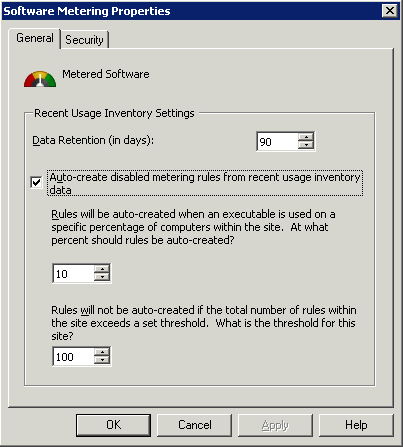10. Software Metering
Use
software metering to monitor and collect software usage data on
ConfigMgr clients. Once this is enabled, you can identify users who use
a certain application, the peak usage times of the application, and
more.
The default schedule collects data
from each client every 7 days. After enabling the agent, right-click
the Software Metering node in the ConfigMgr console and then select
Properties, as shown in Figure 17.

The Data Retention property in Figure 17
specifies how many days the data obtained from the metering rules will
be stored in the database. The 90-day default setting should be
sufficient, unless you plan to trend usage data for over 3 months.
Enable
the check box to auto-create metering rules from recent usage inventory
data. The rules ConfigMgr creates require that you enable them. The two
additional settings in this frame allow you to configure the
requirements for auto-creating rules. By default, rules are
auto-created when an executable runs on 10% of the computers in the
site, unless the total number of rules for the site exceeds 100. To
view rules, simply click the Software Metering node. To enable a rule,
right-click a disabled rule and select Enable. By allowing ConfigMgr to
auto-create metering rules, you will get a better idea of the software
that is installed on a large number of systems in your environment, and
have the ability to easily enable metering for the software.
A
classic example of using this feature is to find a large number of
systems with software such as Microsoft Visio installed. When you see
this new rule, you enable it, and from software metering web reports,
you find that only 20% of the systems that have the software installed
use it on a regular basis. You can now use this information to support
the removal of the licensed application on nearly 80% of the
installation base, thus reducing your software costs.
To
create a new rule, right-click the Software Metering node and select
New -> Software Metering Rule to launch the New Software Metering
Rule Wizard, as shown in Figure 18.

Figure 18
shows a basic rule to meter Microsoft Office Word. Specify the name of
the rule and the exact filename (no wildcards). You can manually enter
the filename, or you can click the Browse button, navigate to the file,
and select it to populate the details automatically on this page.
Alternatively, you can specify the original filename, obtained by
reading the filename from the header of the file. You can enter a
version number to meter a specific version, or use an asterisk to
inventory all versions.
Tip: Do Not Leave the Version Property Blank in the New Software Metering Rule Wizard
Leaving
the Version property blank results in only metering where the file
version is blank in the file header. You may encounter a file in this
situation, but not normally.
The
default language in the wizard is English. If you are uncertain whether
the file you desire to meter will have a consistent language (or if it
doesn’t have a language at all), select -Any-
from the dropdown. Specify the site code that this rule applies to, and
determine whether you want to apply the rule to all child sites of the
specified site code.
11. Software Updates
Configure
the Software Updates Client agent to leverage one of the most popular
(and most important) features of ConfigMgr 2007—patch management.
Note: Activate the Software Update Point
You must have an active software update point (SUP) in the ConfigMgr site in order to use the Software Updates Client agent.
Simply enable the check box on the General tab for the default configuration of the Software Updates Client agent, as shown in Figure 19.

You can then choose for the scan to run a simple or custom schedule. On the Update Installation tab, you can choose the client to
install all mandatory deployments, even if a deployment has a deadline
in the future. In this situation, you have multiple deployments
targeting a system, with multiple deadlines. If you enable this check
box, all mandatory updates will be deployed when the first deadline is
reached. This helps to eliminate multiple reboots, and provides a
better end-user experience. You can also choose to hide all display
notifications from end users if desired—this is a sitewide setting,
meaning all Software Updates notifications will be hidden from the
user. To hide notifications on a per-deployment basis, modify the
properties of the desired deployment. The Deployment Re-evaluation tab
allows you to configure enforcement of a patch that was uninstalled. By
default, the client will reevaluate every 7 days to ensure compliance.